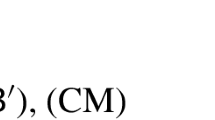Abstract
We present a framework for backward and forward temporal projection that combines dynamic and temporal logic. A propositional dynamic logic for reasoning about actions is extended with temporal modalities; the syntax of this extension differs from the syntax of the converse of programs, previously understood as backwards modalities. An application is carried out to benchmark postdiction examples such as the Stanford Murder Mystery [1] and the Two-Buses Problem [8]. A method for automatically generating frame axioms is used; the axioms so generated are treated as supplementary axioms in the associated proof theory. In future work, we hope to embed this system into a more comprehensive logic for reasoning about actions that enables a unified treatment of the frame, qualification and ramification problems and to work with more ‘scaled-up’ examples.
Preview
Unable to display preview. Download preview PDF.
Similar content being viewed by others
References
A.B Baker. Nonmonotonic reasoning in the framework of the situation calculus. Artificial Intelligence, 49:5–23, 1991.
M.A. Castilho, O. Gasquet, and A. Herzig. Formalizing action and change in modal logic I:the frame problem. Journal of Logic and Computations, 9:701–735, 1999.
N. Foo and D. Zhang. Dealing with the ramification problem in the extended propositional dynamic logic. In Proceedings of Advances in Modal Logic, pages 89–102, 2000.
N. Foo and D. Zhang. Reasoning with extra frame axioms and qualification axioms manuscript. available at http://ftp.cse.unsw.edu.au/pub/users/ksg/Working/action3.zip, 2000.
R. Goldblatt. Logics of Time and Computation. Stanford University Press, 1987.
S. Hanks and D. McDermott. Nonmonotonic logic and temporal projection. Artificial Intelligence, 33(3):379–412, 1987.
D. Harel. First-order dynamic logic. Springer-Verlag, 1979.
G.N. Kartha. Two counterexamples related to baker’ s approach to the frame problem. Artificial Intelligence, 69:379–391, 1994.
H. Kautz. A first order dynamic logic for planning. In Proceedings of the CSCSI/SCEIO, pages 19–26, 1982.
J. McCarthy. Circumscription-a form of nonmonotonic reasoning. Artificial Intelligence, 13, 1980.
Rohit Parikh. The completeness of propositional dynamic logic. In Mathematical Foundations of Computer Science, Lecture Notes in Computer Science, Number 64, pages 403–415. Springer-Verlag, 1978.
J. Pinto and R. Reiter. reasoning about time in the situation calculus. Annals of Mathematics and Artificial Intelligence, 14(2–4):251–268, Sept 1995.
A. Pnueli. The temporal semantics of concurrent programs. Theoretical Computer Science, 13:45–60, 1981.
V.R. Pratt. Semantical considerations on floyd-hoare logic. In Proceedings of the 17th IEEE Symposium on Foundations of Computer Science, pages 109–121, 1976.
H. Prendinger and G. Schurz. Reasoning about action and change: A dynamic logic approach. Journal of Logic, Language, and Information, 5:209–245, 1996.
S. Rosenschein. Plan synthesis:a logical approach. In IJCAI-81, pages 359–380, 1981.
Murray Shanahan. Solving the Frame Problem: a mathematical investigation of the common sense law of inertia. MIT Press, 1997.
Y. Shoham. Chronological ignorance: experiments in nonmonotonic temporal reasoning. Artificial Intelligence, 36:279–331, 1988.
D. Zhang and N. Foo. EPDL: A logic for causal reasoning. In Proceedings of the Seventeenth International Joint Conference on Artificial Intelligence-IJCAI-2001, 2001.
Author information
Authors and Affiliations
Editor information
Editors and Affiliations
Rights and permissions
Copyright information
© 2001 Springer-Verlag Berlin Heidelberg
About this paper
Cite this paper
Chopra, S., Zhang, D. (2001). Postdiction Problems in Dynamic Logic. In: Stumptner, M., Corbett, D., Brooks, M. (eds) AI 2001: Advances in Artificial Intelligence. AI 2001. Lecture Notes in Computer Science(), vol 2256. Springer, Berlin, Heidelberg. https://doi.org/10.1007/3-540-45656-2_11
Download citation
DOI: https://doi.org/10.1007/3-540-45656-2_11
Published:
Publisher Name: Springer, Berlin, Heidelberg
Print ISBN: 978-3-540-42960-9
Online ISBN: 978-3-540-45656-8
eBook Packages: Springer Book Archive




